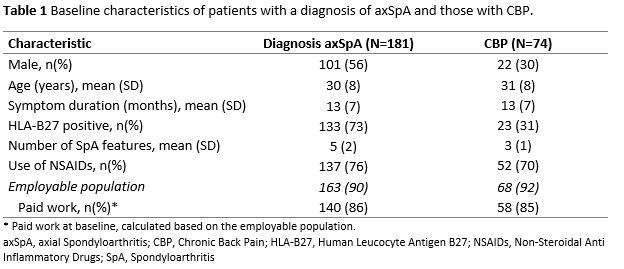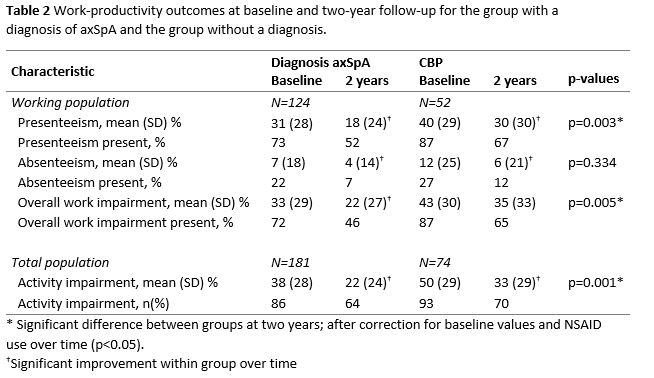Session Information
Date: Monday, November 9, 2020
Session Type: Poster Session D
Session Time: 9:00AM-11:00AM
Background/Purpose: The aim of this study was to compare work-productivity and activity impairment outcomes after two-year follow-up between chronic back pain (CBP) patients with and without an axSpA diagnosis
Methods: Patients over 16 years of age referred to the rheumatology outpatient clinic with chronic back pain (≥ 3 months < 2 years) starting before the age of 45, suspected of axSpA were included in the SPACE cohort. Follow-up was performed only in patients with at least two SpA features or one SpA feature with a positive likelihood ratio ≥6.4 (Rudwaleit, van der Heijde, Khan, Braun, & Sieper, 2004).
Work productivity was assessed using the Work Productivity and Activity Impairment (WPAI) general health version 1.0 questionnaire. Presenteeism was defined as a reduction in performance while at work due to disease; absenteeism was time missed from work due to disease; work productivity loss (WPL) was a combined measure of presenteeism and absenteeism; and activity impairment was impairment due to disease in all non-work related activities. All WPAI outcomes were presented as percentages between 0-100; higher scores implying greater impairment. Additionally, the proportion of patients with any ( >0%) absenteeism, presenteeism, WPL and activity impairment were given.
Assessment of presenteeism, absenteeism and WPL was restricted to the working population, defined as having paid work at baseline and 2-year follow-up. Activity impairment was assessed for the entire study population. The employable population was defined as everyone of working age ( >16), who was not a fulltime student.
In this study we included patients with a diagnosis axSpA or no axSpA (CBP group) all with a level of confidence ≥7 (on a 0-10 scale) after locally read imaging. Additionally, data had to be available on the WPAI questionnaire at both timepoints.
Regression models were used to test the difference between groups at two-year follow-up for each of the WPAI variables. Baseline WPAI values and NSAID-use over time were tested as confounders.
Results: Patients with a diagnosis of axSpA were more frequently male and HLA-B27 positive and had more SpA features at baseline compared to the patients with CBP (Table 1). Age, symptom duration, NSAID-use and the percentage of patients with paid work at baseline were similar between groups.
The population having paid work at baseline and 2 years consisted of 124 patients (69%) in the axSpA group and 52 patients (70%) in the CBP group. In both groups the proportion of patients with any as well as the mean WPL reduces. This reduction was apparent in both presenteeism and absenteeism. Nevertheless, presenteeism, WPL and activity impairment were significantly higher at two-year follow-up in the group with CBP (Table 2). In these regression models with baseline values and NSAID-use over time as covariates, axSpA was an independent predictor of lower presenteeism, overall work impairment and activity impairment at two-year follow-up (data not shown).
Conclusion: Despite significant improvements in both groups, patients with a diagnosis of axSpA have significantly better work-related outcomes after two years of protocolised follow-up compared to patients with CBP.
 Table 1 Baseline characteristics of patients with a diagnosis of axSpA and those with CBP.
Table 1 Baseline characteristics of patients with a diagnosis of axSpA and those with CBP.
 Table 2 Work-productivity outcomes at baseline and two-year follow-up for the group with a diagnosis of axSpA and the group without a diagnosis.
Table 2 Work-productivity outcomes at baseline and two-year follow-up for the group with a diagnosis of axSpA and the group without a diagnosis.
To cite this abstract in AMA style:
Boel A, van Lunteren M, Fagerli K, Ramonda R, Exarchou S, van de Sande M, van Gaalen F, van der Heijde D. Comparison of Work Productivity Outcomes Between Chronic Back Pain Patients with and Without a Diagnosis of Axial Spondyloarthritis After 2-Year Protocolised Follow-Up: Data from the Spondyloarthritis Caught Early Cohort [abstract]. Arthritis Rheumatol. 2020; 72 (suppl 10). https://acrabstracts.org/abstract/comparison-of-work-productivity-outcomes-between-chronic-back-pain-patients-with-and-without-a-diagnosis-of-axial-spondyloarthritis-after-2-year-protocolised-follow-up-data-from-the-spondyloarthritis/. Accessed .« Back to ACR Convergence 2020
ACR Meeting Abstracts - https://acrabstracts.org/abstract/comparison-of-work-productivity-outcomes-between-chronic-back-pain-patients-with-and-without-a-diagnosis-of-axial-spondyloarthritis-after-2-year-protocolised-follow-up-data-from-the-spondyloarthritis/
